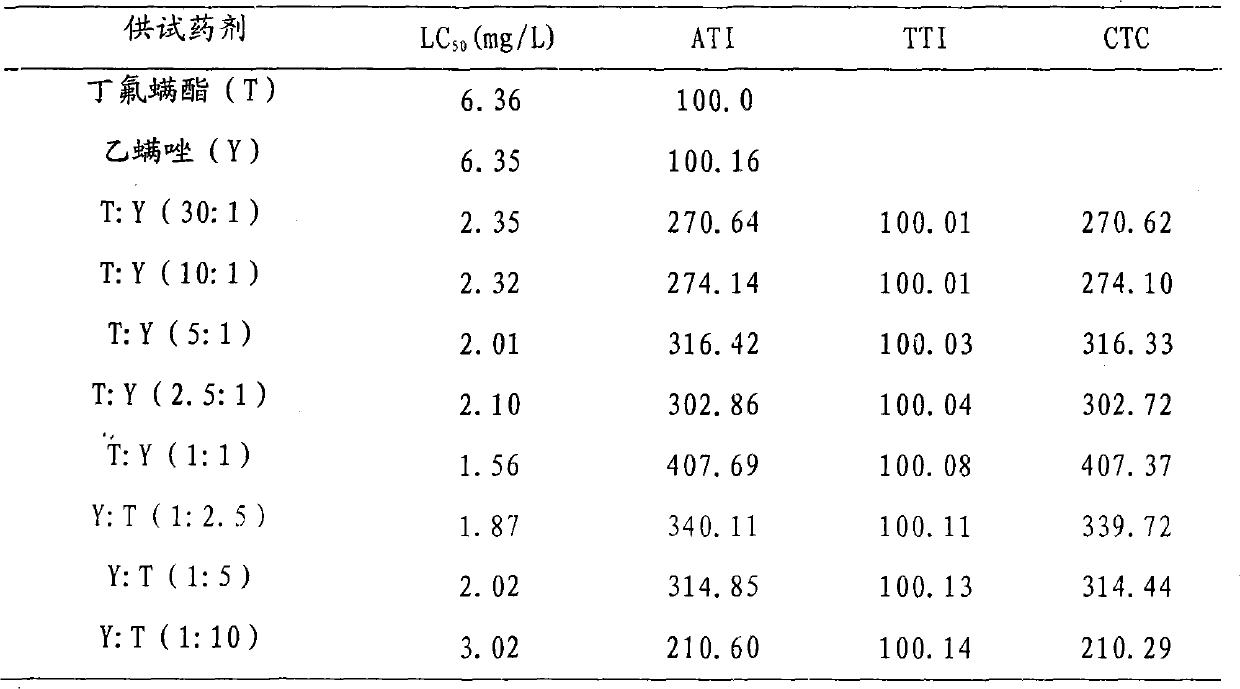Pesticide composition for preventing and treating drug-fast tetranychid mites
A technology of pesticide composition and etoxazole, which is applied in the field of pesticide composition, can solve the problems of pest mite resistance and poor quick-acting of pesticides, and achieve the effect of reducing the amount of pesticide usage, reducing adverse effects, and reducing pesticide residues
- Summary
- Abstract
- Description
- Claims
- Application Information
AI Technical Summary
Problems solved by technology
Method used
Image
Examples
Embodiment 1
[0022] Example 1: Toxicity determination of cyflufenate, etoxazole and different ratios to Panonychus citrus
[0023] The test method refers to the "People's Republic of China Agricultural Industry Standard NY / T1154.12-2006". Sensitive test insects came from Nanjing Agricultural University. After 30 generations of indoor breeding of female adult mites of Panonychus citrus, the female adult mites with uniform growth were selected as the test insects. The resistance test insects were collected from Sihui City, Guangdong Province, where Panonychus mites have high resistance to spirodiclofen. Female adult mites with uniform growth were selected as the test insects. The test adopts the small seedling method, that is, 50-60 whole claw mites are inoculated on small pots of citrus seedlings, and the base number is checked after 1 day. After the dead mites are picked out, live adult mites are added, and the number of mites per treatment is kept at about 50 . Spray the seedlings with...
Embodiment 2
[0035] Example 2: Toxicity determination of cyflumetate, etoxazole and different ratios to Tetranychus urticae
[0036] The test method refers to the "People's Republic of China Agricultural Industry Standard NY / T1154.12-2006". Sensitive populations come from Tetranychus urticae raised indoors all the year round in the Noposon Research Institute; resistant populations are directly collected from Tetranychus urticae in Longgang area, Shenzhen, and female adult mites with uniform growth are selected as the test insects. Adopt cotton seedling method, test method and statistical method are with embodiment 1.
[0037] The test results are shown in Table 3 and Table 4.
[0038] Table 3 Toxicity determination of cyflufen, etoxazole and different ratios of Tetranychus urticae (susceptible species to etoxazole) (15 days)
[0039]
[0040] Table 4 Toxicity determination (15 days) of cyflufen, etoxazole and different ratios of Tetranychus urticae (to etoxazole resistant population, ...
Embodiment 3
[0043] Example 3: Toxicity determination of cyflumetate, etoxazole and different ratios to Tetranychus cinnabarinus
[0044] The test method refers to the "People's Republic of China Agricultural Industry Standard NY / T1154.12-2006". Female adults of Tetranychus cinnabarinus collected from the field were reared indoors for 30 generations, and the female adults with uniform growth were selected as the test insects. Adopt tomato seedling method, test method and statistical method are with embodiment 1.
[0045] The test results are shown in Table 5.
[0046] Table 5 Toxicity determination of cyflufen, etoxazole and different ratios of Tetranychus cinnabarinus sensitive populations (15 days)
[0047]
[0048] It can be seen from Table 5 that when the weight ratio of cyflumet and etoxazole is mixed in the range of 30:1 to 1:30, the co-toxicity coefficient of each ratio reaches above 120, showing a certain synergistic effect.
PUM
 Login to View More
Login to View More Abstract
Description
Claims
Application Information
 Login to View More
Login to View More - R&D
- Intellectual Property
- Life Sciences
- Materials
- Tech Scout
- Unparalleled Data Quality
- Higher Quality Content
- 60% Fewer Hallucinations
Browse by: Latest US Patents, China's latest patents, Technical Efficacy Thesaurus, Application Domain, Technology Topic, Popular Technical Reports.
© 2025 PatSnap. All rights reserved.Legal|Privacy policy|Modern Slavery Act Transparency Statement|Sitemap|About US| Contact US: help@patsnap.com



